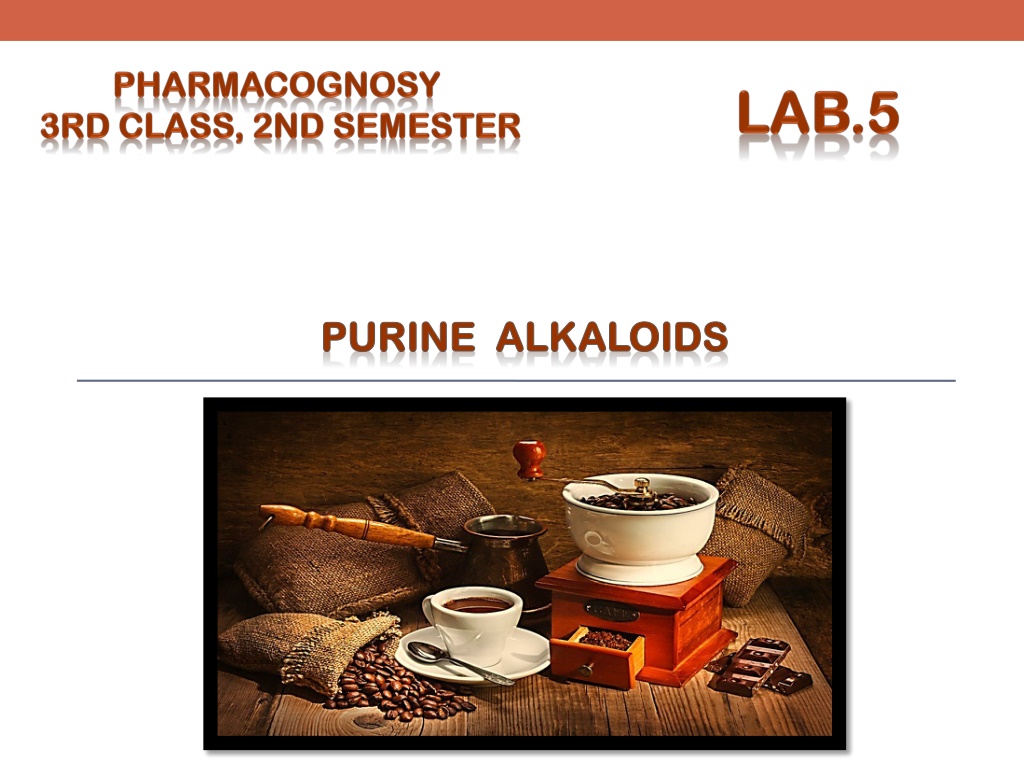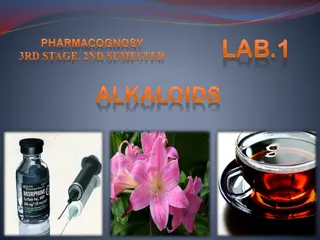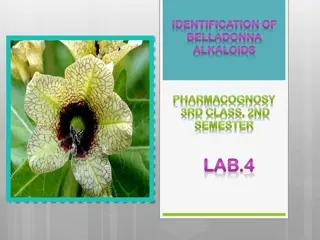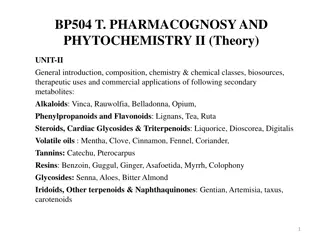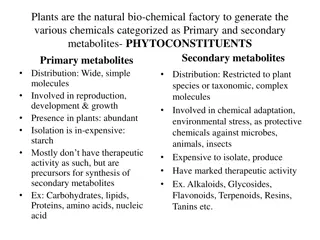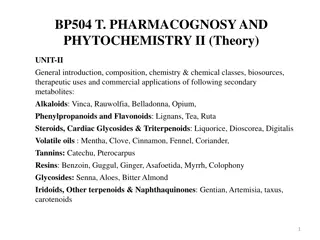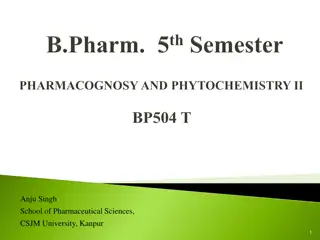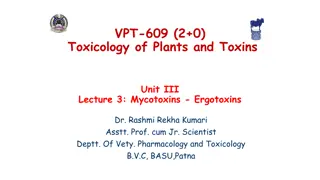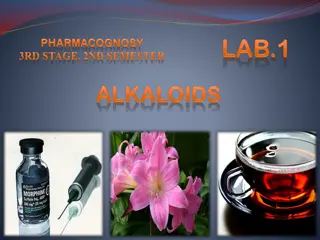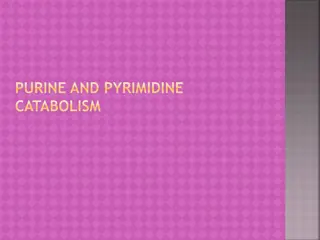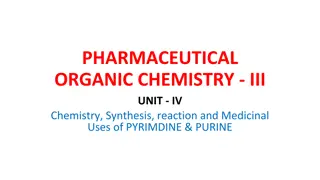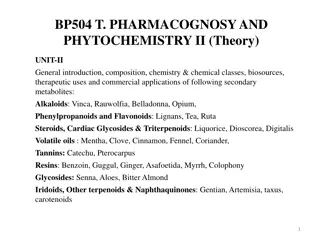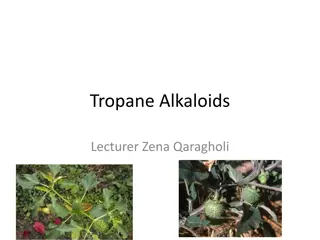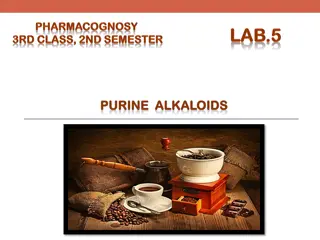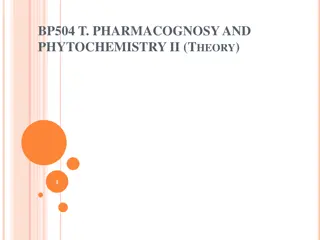Understanding Purine Alkaloids and Their Pharmacological Activities
Purine alkaloids are a class of compounds with a unique structure, different from typical alkaloids. They include caffeine, theophylline, and theobromine, each with distinct effects on the body. These compounds are found in plants like coffee, tea, and cola, and have various pharmacological activities such as CNS stimulation, diuretic effects, and bronchial muscle relaxation. Isolating caffeine from tea involves specific equipment and reagents for extraction. Discover more about purine alkaloids and their significance in pharmacology.
Download Presentation

Please find below an Image/Link to download the presentation.
The content on the website is provided AS IS for your information and personal use only. It may not be sold, licensed, or shared on other websites without obtaining consent from the author. Download presentation by click this link. If you encounter any issues during the download, it is possible that the publisher has removed the file from their server.
E N D
Presentation Transcript
PURINE ALKALOIDS PURINE ALKALOIDS
Introduction Purines nucleus is a heterocyclic nucleus consisting of pyrimidine ring fused to 5-membered imidazole ring known as xanthine.
Amphoteric Character Purines unlike other alkaloids do not give positive results with general tests of alkaloids; instead murexide test (Purple Color) is used in its identification. Purines are present as methylated compound, which are:- 1) Caffeine (1, 3, 7-tri methylxanthine). 2) Theophylline (1, 3,-dimethylxanthine). 3) Theo bromine (3, 7-dimethylxanthine).
Caffeine: stimulates CNS and has a weak diuretic action. Theobromine: opposite action. Theophylline: relaxes involuntary muscles more effectively than caffeine or theobromine Caffeine: does not precipitate like most alkaloids.
Generally the pharmacological activities of the Purine Alkaloids 1) Stimulation of the CNS. 2) Diuretic effect. 3) Increase gastric acid secretion. 4) Relaxation of the bronchial smooth muscle (theophylline). 5) Positive inotropic and chronotropic effect on the heart.
The most important plants in this group are:- 1) Coffee (Coffea arabica of the family Rubiaceae) contain about 1-2% of caffeine. 2) Tea (Camellia sinensis of the family Theaceae) contain about 1-4% of caffeine. 3) Cola (Cola nitida of the family Sterouliaceae) contain about3.5% of caffeine.
Isolation Of Caffeine From Tea AIM: - To isolate the caffeine alkaloid from tea. Equipments and reagent:- Large beaker and small beaker Water bath Muslin Centrifuge test tubes Evaporating dish Boiling water Separatory funnel Basic lead acetate Sulphuric acid Decolorized charcoal Chloroform Hot 60C ethanol
50 gm. of coarsely powder tea 250 ml of water and boil gently for 15 min. Strain the resulting hot extract through muslin 1 2 Add solution of basic lead acetate to the filtrate until no more precipitate is formed. 4 Wash the mass remains on the muslin with 250 ml of boiling water and express again. 3 Heat the mixture to boiling and place rapidly in a centrifuge test tubes for 5min. Collect the supernatant result, heated to boiling. 5 6 Add 1gm of decolorized charcoal to the filtrate then evaporated over a low Bunsen flame with frequent stirring until a volume of 75-100 ml is reached. 8 Add dilute Sulphuric acid until precipitation ceases. 7
9 Filtration Evaporation 10 11 Cool, transfer to a separatory funnel and shake out with three successive 10 ml portion of chloroform. Transfer the combined chloroform extract to a small evaporating dish. 12 Transfer to a small beaker and dissolve in the smallest quantity of hot 60 c ethanol necessary to affect the solution. 13 Evaporate the chloroform on steam bath in the hood. Allow the solution to stand overnight. 14
Procedure:- 1) Place 50 gm. of coarsely powder tea and 250 ml of water in a 600 ml beaker and boil gently for fifteen minute with constant stirring. 2) Strain the resulting hot extract through muslin, expressing as much of the liquid as possible from the leaf material. 3) Wash the mass remains on the muslin with 250 ml of boiling water and express again. 4) Carefully add solution of basic lead acetate to the filtrate until no more precipitate is formed. 5) Heat the mixture to boiling and place rapidly in a centrifuge test tubes, and centrifuge for five minutes, complete centrifugation to the whole extract. 6) Collect the supernatant result, heated to boiling. 7) Add dilute Sulphuric acid until precipitation ceases.
8) Approximately 1gm of decolorized charcoal is added to the filtrate which is then evaporated over a low Bunsen flame with frequent stirring until a volume of 75-100 ml is reached. 9) Evaporation of the large volume of the liquid may be carried out in portions in a smaller evaporating dish. 10) The solution is filtered hot, returning the first portion collected back through the filter until a clear filtrate is obtained. 11) Cool, transfer to a separatory funnel and shake out with three successive 10 ml portion of chloroform. 12) Transfer the combined chloroform extract to a small evaporating dish. 13)Carefully evaporate the chloroform on steam bath in the hood. 14)Scrap out the residue, transfer to a small beaker and dissolve in the smallest quantity of hot 60 c ethanol necessary to affect the solution. 15) Allow the solution to stand overnight.
Results:- Pure crystals with a white color will be obtained. Discussion:- Purines differ from other alkaloids in that they are soluble in hot water, which is used in it is extraction, and this is the cause why all the time you should heat the mixture ( to prevent the precipitation of caffeine in cold water). Addition of basic lead acetate is to precipitate the tannins and other unwanted materials. Addition of dilute Sulphuric acid is to take the excess of lead acetate. The centrifugation is used to isolate the decant containing the unwanted material from the desired supernatant. Addition of charcoal is for the decolorization, so that the crystals will take its normal white color. Use of chloroform is to extract the caffeine from other component of the mixture. Use of hot ethanol is for the recrystallization process.
THANK YOU THANK YOU
